Eran is a small town in Sagar, Madhya Pradesh and It is one of the most ancient towns in India. Eran also known as ‘Erakanya or Erakina’ in old scripts. Gets its name because of the Tall Grass (Elephant Cattail) which grows here in large.
Initially, it was an important route connecting to Patliputra with Mathura via Vidisha. Hence it had a very prominent place in history due to it being the main route. Alexander Cunningham discovered this town and he noticed the antiques of this place. During Bheem’s phase of exile and thus Eran also has a Mahabharata connection.

History of Eran:
The historical significance of Eran depicts very interesting stories and facts about the place. Many historians and voyagers came across this place and luckily viewed the antiques around Eran. The very first discovery took place in 1838. After Alexander Cunningham, the excavations took place around the 1960s and then in the 80’s post-independence.
Eran was ruled by the Mauryans, Guptas, Satavahanas, Chandellas to name a few dynasties.
Located at the banks of river Bina, Eran’s existence is borne by the remains of the old fort here. A large number of coins are unearthed and observed here. Nearly 3000! The most important findings are the copper coins back from the 3rd century BC.
There are many silver coins as well with pictures of Lord Vishnu, Garuda, etc. Apart from these, excavations from Naga and Saka period along with the Mughal period are found here. Eran’s history is all about its inscriptions. Eran is also popular for pillars- monuments remembering Sati practices. The Sati pillars gave the archaeologists the date and content of practice. It existed right from the Gupta dynasty till the 20th century.

Heritage and importance of Eran:
Eran is famous for its heritage sites. It is remote and hidden from the eyes of the world. It turned out to be hidden because of its location. Its current size and lack of exposure make this place hidden. Whereas in past, it was once important for the routes, rituals and places of visit. With the powerful presence of mighty rulers and their empires. Eran would have certainly been a delight to the eyes back in time.
However, the site could not be preserved much. We can only see a glimpse of the past through the ruins that are left behind. Every kingdom and Empire has uniquely contributed to the architecture of Eran. Thus we see several different temples devoted to different gods and goddesses, various inscriptions in different languages on pillars, etc. However, The Gupta Dynasty’s influence over Eran Reflects the most in what is left of the place.
Eran’s Heritage can be noticed in the region’s temples and pillars, Coins, and Inscriptions. Reflects upon what the place could have been back in time when it was a prominent destination.

Temples and Pillars:
Eran is home to one of the most unique Vishnu avatar temples in India. The Varaha Temple where Lord Vishnu is portrayed in a Man-Boar Avatar. The Varaha idol or statue is one of the oldest idols of Lord Vishnu and has many intricate details. That suggests Lord Vishnu saved Goddess Earth and brought her back safely by killing Hiranyaksha- a demon.

Coins:
Eran is also referred to as a coin mint for Mighty Indian Kingdoms as it did not only produce coins. Although, also three other kingdoms namely- Vidisha, Ujjain and Tripuri. Gave the Ancient Indian Civilisation some of the finest and most thoughtfully made copper coins. Introduced new methods of coin making like the die-struck method, inscribed coins, cast coins, etc apart from the commonly used punch-marked coins. Square coins were Eran mint’s speciality coins.
Inscriptions:
There are at least 4-to 5 different inscription languages and text found at Eran. The first inscription begins from the Saka Ruler Sridharavarman followed by Bhanugupta, and then by Samudragupta who belonged to the Gupta empire, followed by Budhagupta and lastly Toramana.
Follow India Chalk on Instagram for more amazing travel content. You can share your travel story with us. Reach out to us on email at contact[at]ndiachalk[dot]com. This blog is curated by India Chalk and written by Manasi Sapre.






